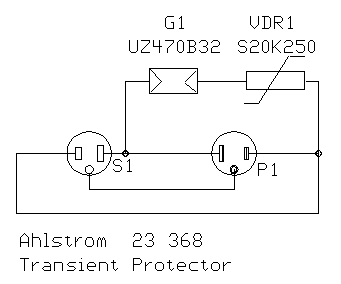Mains transient surge suppression
What is a Transient?
Transients are generally divided into two basic categories:
- natural occurring transients such as lightning
- transients caused by other equipment
Power lines running overhead or even underground can have voltage induced in them either by a direct or indirect strike of lightning. The voltage induced to those wiring is typically very short time but high energy pulse.
Transients caused by other equipment are usually caused by the discharge of stored energy in inductive and capacitive components. Electric motors, such as those used in elevators, heating, air conditioning, refrigeration or other inductive loads, can create a continuous stream of 250V to 1000V transients. DC motor drives, variable speed AC motor drives, DC power supply switching, and portable power tools are other sources of transients.
A more elusive transient is one caused by the switching of inductive loads. A 250V to 3000V transient can occur with the interruption of an inductors current. This type of transient occurs when opening and closing contacts to electric motors or fluorescent lighting using magnetic ballasts. Two other sources are arc welders and furnace ignitors. Electric wiring carrying signals from these sources can induce voltages in other conductors in close proximity.
Surge suppressor circuit
The following circuit is a schematic of mains transient surge suppressor circuit manufactured by Str�mfors and sold undel model name "Ahstrom Transienttisuoja 23 386". The schematic is drawn by opening one protector and looking what's inside it.
The circuit is designed to protect sensitive electronic devices agains overvoltage transients in normal mains voltage. The circuit is designed for use in Finland where the mains voltage is 230V AC and the maximum fuse size for mains connector group is 16A. The surge protector is connected between main outlet and the equipment to be protected. The protector handles only the overvoltage between live and neutral wires (no common mode surge protection). This surge protector is suitable to be used with both grounded and non-grounded wall outlets.
Here is the technical specs from manufacturers sheet:
Operation voltage 230 V AC Max. Operation current 16 A Max. group fuse size 16 A Cutting voltage (0,2/50 microsecond pulse) 850 V @ 80 A Max. current pulse (8/20 microsecond pulse, 10 pulses) 2000 A
And here is the schematic of the surge protector:
The circuit is quite basic surge suppression circuit which consists of VRD and gas surge suppressor connected in series. The protection circuit is connected between live and mains leads. Normally no current flows through G1 and VDR1. When the voltage between those wires is higher than the sum of voltage ratings of G1 and VDR1 current starts to flow through those components. More the voltage raises more current starts to flow through G1 and VDR1 which causes that can't rise much over that predetermined value. When the voltage again goes back to normal values G1 and VDR1 stop to conduct.
The circuit does not have any built-in fuses because it is rated so that it can handle the whole 16A current which is available in mains connectors in Finland. If the surge is very powerful the mains fuse in the distribution board will blow.
Tomi Engdahl <[email protected]>










